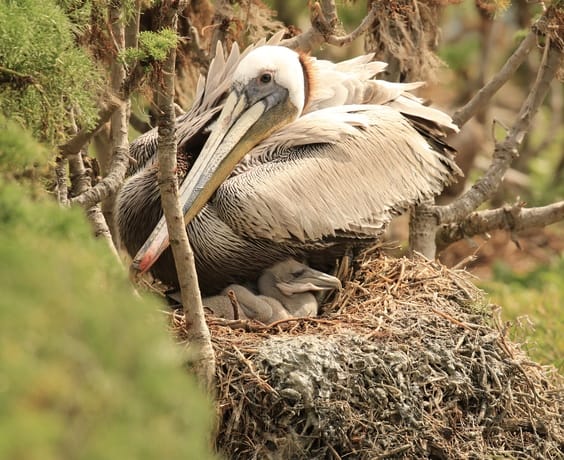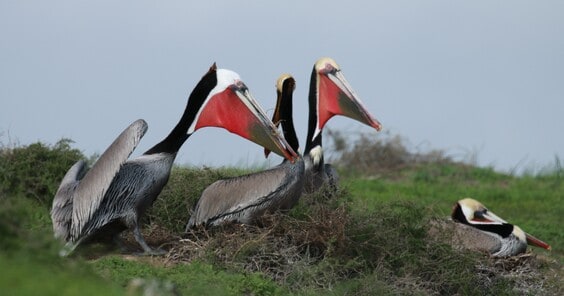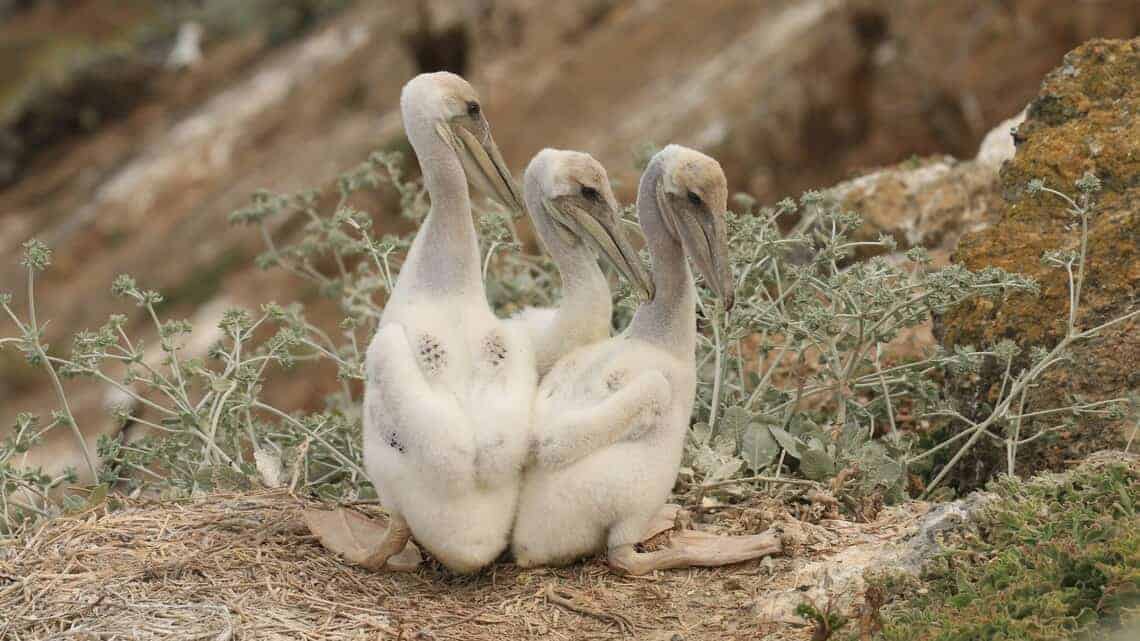Jim Howard, Seabird Biologist, California Institute of Environmental Studies

While hiking across the island of West Anacapa in September for the “End of Season Survey,” the recovery of the California Brown Pelican is all around you and smells like ammonia. More than ten thousand pelican nests are clustered on the ground and in the branches of oaks and cherry trees. Each season, breeding adults add to existing nest structures or create new ones, with materials pulled from nearby native shrubs and lined with grass. Counting all the nests at Anacapa Island takes a dedicated crew of six to eight people three full days of hiking carefully through the native coastal scrub habitat, marking and tallying each nest.
Looking at all these nests now, you would not know that the situation was very different in 1970 when the California Brown Pelican was listed on the Federal Endangered Species list. For decades, the Southern California Bight was the disposal site for the manufacturing effluent of dichlorodiphenyltrichloroethane (DDT), a very effective insecticide. These chemicals bioaccumulated in the food chain and affected the ability of these fish-eating birds to effectively deposit calcium onto their eggs, leading to eggshell thinning. These thin eggshells, less than a third of a millimeter thick, were crushed beneath the incubating adults and resulted in a dwindling population, with only about 500 nests on the island. The situation appeared especially dire when only one chick was documented fledging in 1971.
Despite the chemicals’ lingering effects, recovery began to be noticeable about a decade after the 1972 ban on DDT use in the United States. By 1985, nesting at Anacapa Island had increased by an order of magnitude to nearly 5000 nests. Over the next 20 years nest numbers would slowly increase, peaking in 2004 at around 8000 nests. With thicker eggshells producing surviving chicks and the population appearing to be on a stable trajectory, the California Brown Pelican was taken off the Endangered Species list in 2009, and this coastal icon was celebrated as “recovered”.

Unfortunately, soon after delisting, the Channel Islands pelican population declined dramatically when their primary food sources, particularly northern anchovy, crashed. Between 2009 and 2013, pelican numbers were low enough to worry experts that perhaps removal from the endangered species list was premature. Beginning about 2014, ocean conditions around the Channel Islands showed signs of improving and anchovy populations began rebounding. With their primary prey increasing, pelican populations responded again dramatically. Nest numbers are soaring, and pelicans have begun nesting earlier and longer into the year. In some years nesting has been nearly year-round, when historically nesting was only from February through August. Good prey availability has resulted in upwards of 12,000 nests at Anacapa Island in 2021.

This increase in nesting in the Channel Islands is exciting and gives us hope for the future of the California Brown Pelican, but it is only one part of the story. The portion of the population breeding in Mexico’s Gulf of California have been experiencing near complete reproductive failure during this same period (2014-2021) and make up a much larger proportion of the population. Gulf of California birds may be relocating northward to nest at the Anacapa and Santa Barbara Island colonies, potentially seeking better food availability. To investigate the connectivity between these populations, researchers in Mexico and the United States are looking to collaborate using banding and tracking technologies. Important questions for researchers include where young pelicans disperse to after fledging and if they return to their natal colony or choose a different colony for nesting. Answering these questions will help biologists better understand the dynamics at work so they are better able to manage this charismatic and iconic species throughout its entire breeding range.
For more information on the Channel Islands population of California Brown Pelican, please contact Jim Howard at California Institute of Environmental Studies or David Mazurkiewicz at Channel Islands National Park. Also please visit CIES’s website for additional information about this and other projects with seabirds and habitat restoration.

